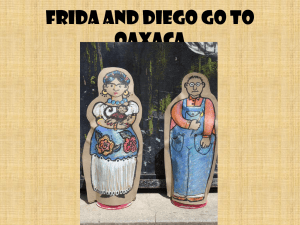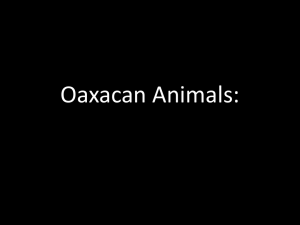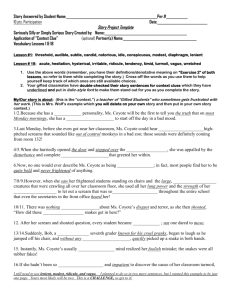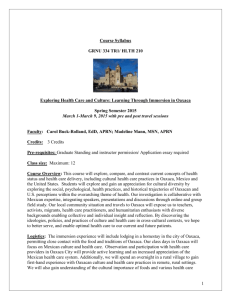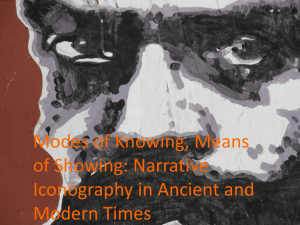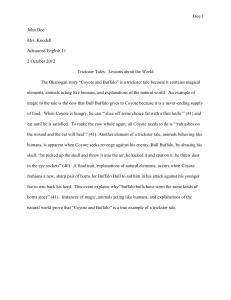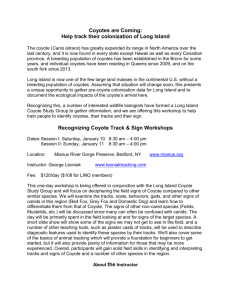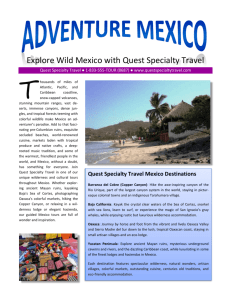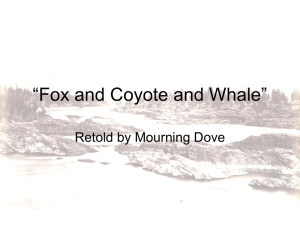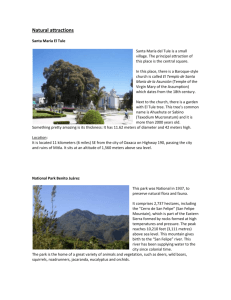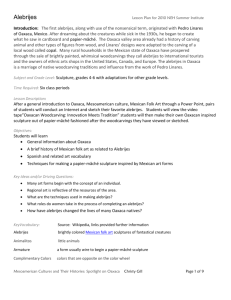Juana Sánchez Jiménez NEH Fellow, Mesoamerica 2015 Teaching
advertisement
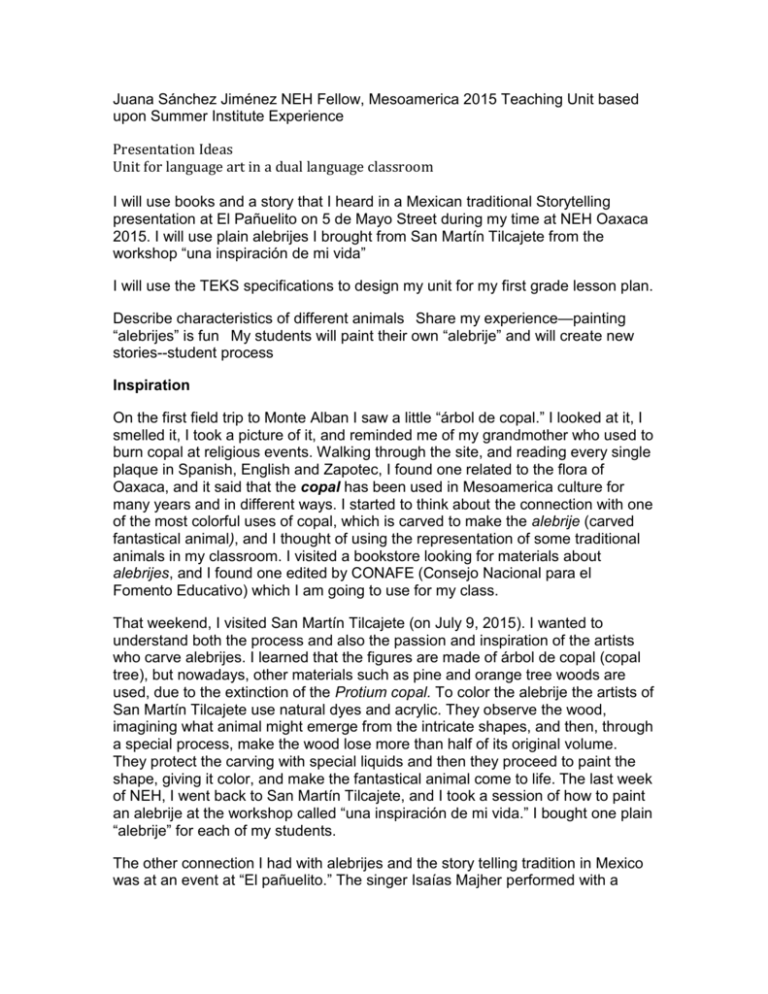
Juana Sánchez Jiménez NEH Fellow, Mesoamerica 2015 Teaching Unit based upon Summer Institute Experience Presentation Ideas Unit for language art in a dual language classroom I will use books and a story that I heard in a Mexican traditional Storytelling presentation at El Pañuelito on 5 de Mayo Street during my time at NEH Oaxaca 2015. I will use plain alebrijes I brought from San Martín Tilcajete from the workshop “una inspiración de mi vida” I will use the TEKS specifications to design my unit for my first grade lesson plan. Describe characteristics of different animals Share my experience—painting “alebrijes” is fun My students will paint their own “alebrije” and will create new stories--student process Inspiration On the first field trip to Monte Alban I saw a little “árbol de copal.” I looked at it, I smelled it, I took a picture of it, and reminded me of my grandmother who used to burn copal at religious events. Walking through the site, and reading every single plaque in Spanish, English and Zapotec, I found one related to the flora of Oaxaca, and it said that the copal has been used in Mesoamerica culture for many years and in different ways. I started to think about the connection with one of the most colorful uses of copal, which is carved to make the alebrije (carved fantastical animal), and I thought of using the representation of some traditional animals in my classroom. I visited a bookstore looking for materials about alebrijes, and I found one edited by CONAFE (Consejo Nacional para el Fomento Educativo) which I am going to use for my class. That weekend, I visited San Martín Tilcajete (on July 9, 2015). I wanted to understand both the process and also the passion and inspiration of the artists who carve alebrijes. I learned that the figures are made of árbol de copal (copal tree), but nowadays, other materials such as pine and orange tree woods are used, due to the extinction of the Protium copal. To color the alebrije the artists of San Martín Tilcajete use natural dyes and acrylic. They observe the wood, imagining what animal might emerge from the intricate shapes, and then, through a special process, make the wood lose more than half of its original volume. They protect the carving with special liquids and then they proceed to paint the shape, giving it color, and make the fantastical animal come to life. The last week of NEH, I went back to San Martín Tilcajete, and I took a session of how to paint an alebrije at the workshop called “una inspiración de mi vida.” I bought one plain “alebrije” for each of my students. The other connection I had with alebrijes and the story telling tradition in Mexico was at an event at “El pañuelito.” The singer Isaías Majher performed with a ukulele and tortoise shell to a crowd of children audience and he used an ukulele and a turtle shall to tell the story “el buho, la lagartija y el coyote” (“The Owl, the Lizard, and the Coyote”). Following the performance, I talked to Isaías and got more ideas about teaching through storytelling. Finally I consulted the TEKS requirments (Texas Essential Knowledge and Skills), which are the state education standards, and I planed a unit so that I may use my experience, knowledge and my student’s creativity to study Language Arts based on the curriculum. My students will listen, read write and talk about alebrijes, and I will be proud and pleased to see the extension of NEH in my classroom. NEH Unit: Oaxaca First Grade Dual Language Day 1 Language Arts Topic: Los alebrijes de Oaxaca TEKS Lesson Objective: 1.3F Identify words that name actions (verbs) and words that name people, places, or things (nouns). Materials and Resources: • Book: El alebrije by Carlos Maltés ISBN 968-29-8458-0 • Different animal pictures • Plain alebrijes from San Martín Tilcajete • Liquid tempera paint • Painting bowls • Watercolor paintbrushes • Toothpicks Vocabulary: vivir, hablar, decir, sentir, pensar, pintar, tortuga, coyote, caballo, rana, campo, camino, cactus, madera. Engage/Motivate: Talk about magic animals in story telling. Explain that this week you will read a fiction book about “alebrijes” and ask if they have heard that word. Whole Group Instruction: Read aloud “alebrijes” discuss with them the theme of the story, you can ask explicit and implicit questions. Ask the children to tell what they know about the animals that appear in the story: how they are, where they live, what they do. Ask if they know what they are called parts of the animals, unlike humans, are called: muzzle, horn, hooves, etc. Ask the group to opine on how to write these words and write them on the board. Ask the children to name the names of some human body parts (feet, arms, face) and write them on the board. Discuss with them the writing of these words. Invite the children to reflect on the characteristics of real-life animals, and those that appear in stories, books, or other resources such as encyclopedias that they have consulted in the library. Ask them to name the differences between real animals those that appear in stories. For example, in animal tales they speak, dress and act like people, while in (non-fiction) books, that does not happen. Ask what other characters in addition to the animals, we find in stories. Small Group/Guided Reading Instruction: Explain that now the students will write the names of human and animal body parts in their notebooks. Suggest that they work in pairs and that the pairs consult the words analyzed on the blackboard. Independent Practice: Model how to make an “alebrije.” At the Art Center students will start to make their own “alebrije” Evaluate Understanding/Assignment: Record on a checklist each individual’s participation. Ask them to take a picture of an animal and observe it and discuss how they are alike and how they are different. Then discuss the human being is also part of the animal kingdom. Ask them to compare body parts with those of animals, ask what they look like and why. Closing Activity: explain to the students what an “alebrije” is and share your experience in Oaxaca making an “alebrije”. **Word Study: Teach vocabulary in the whole group session Day 2 Language Arts Topic: Los alebrijes de Oaxaca TEKS Lesson Objective: 1.7A Connect the meaning of a well-known story or fable to personal experiences. 1.9A Describe plot (problem and solution) and retell a story’s beginning, middle, and end with attention to the sequence of events. 1.9B Describe characters in a story and the reasons for their actions and feelings. Materials and Resources: • Different animal pictures • Oral Story telling: “el buho, la lagartija y el coyote” by Isaias Majher (you can tell any story that involves animals) • Plain Alebrijes from San Martín Tilcajete • Liquid Tempera Paint • Painting Bowls • Watercolor Paintbrushes • Toothpicks Vocabulary: vivir, hablar, decir, sentir, pensar, pintar, tortuga, coyote, caballo, rana, campo, camino, cactus, madera. Engage/Motivate: Talk about animals living together in a same space and how they relate to each other. Explain you will tell them a story about some animals from Oaxaca ““el buho, la lagartija y el coyote” Whole Group Instruction: Read the oral story. Invite the children to comment on the story. Ask them to remember and discuss if you ever have heard another story about a tenacious character. You have the children draw the story sequence and to indicate what happened first? Where? What happened in the end? Small Group/Guided Reading Instruction: Divide the children into teams so that each expose the order that gave the story. Ask the children to describe the characteristics of each animal and what makes them special and different from others. Ask the children to write sentences for each animal and to use appropriate for each adjective. Independent Practice: allow children to continue developing their “alebrije.” Evaluate Understanding/Assignment: Record on a checklist the individual participation. Closing Activity: share your experience in Oaxaca making an “alebrije”. **Word Study: In small group session Day 3 Topic: Alebrijes de Oaxaca TEKS Lesson Objective: 1.7A Connect the meaning of a well-known story or fable to personal experiences. 1.9A Describe plot (problem and solution) and retell a story’s beginning, middle, and end with attention to the sequence of events. 1.9B Describe characters in a story and the reasons for their actions and feelings. Materials and Resources: • Different animal pictures • Oral Storytelling: “el buho, la lagartija y el coyote” by Isaias Majher (you can tell any story that involves animals) • Plain Alebrijes from San Martín Tilcajete • Liquid tempera paint • Painting bowls • Watercolor paintbrushes • Toothpicks Vocabulary: vivir, hablar, decir, sentir, pensar, pintar, tortuga, coyote, caballo, rana, campo, camino, cactus, madera. Engage/Motivate: Ask the students if they liked the experience of painting their “alebrijes.” Whole Group Instruction: Ask them if any of them have completed their “alebrije” and I would describe the animal has finished painting. Ask the student to describe his “alebrije” pass on the actual characteristics of that animal. Then you ask the group about the features you can have that animal as a character in a story. Small Group/Guided Reading Instruction: Groups the children into teams of three and have them write a story with each “alebrijes” has. Helps students to follow a clear and logical sequence in his writing. Independent Practice: Ask each student to describe in his notebook the character he most liked. Evaluate Understanding/Assignment: Record on a checklist the individual participation. Closing Activity: share your experience in Oaxaca making an “alebrije”. **Word Study: In small group session
